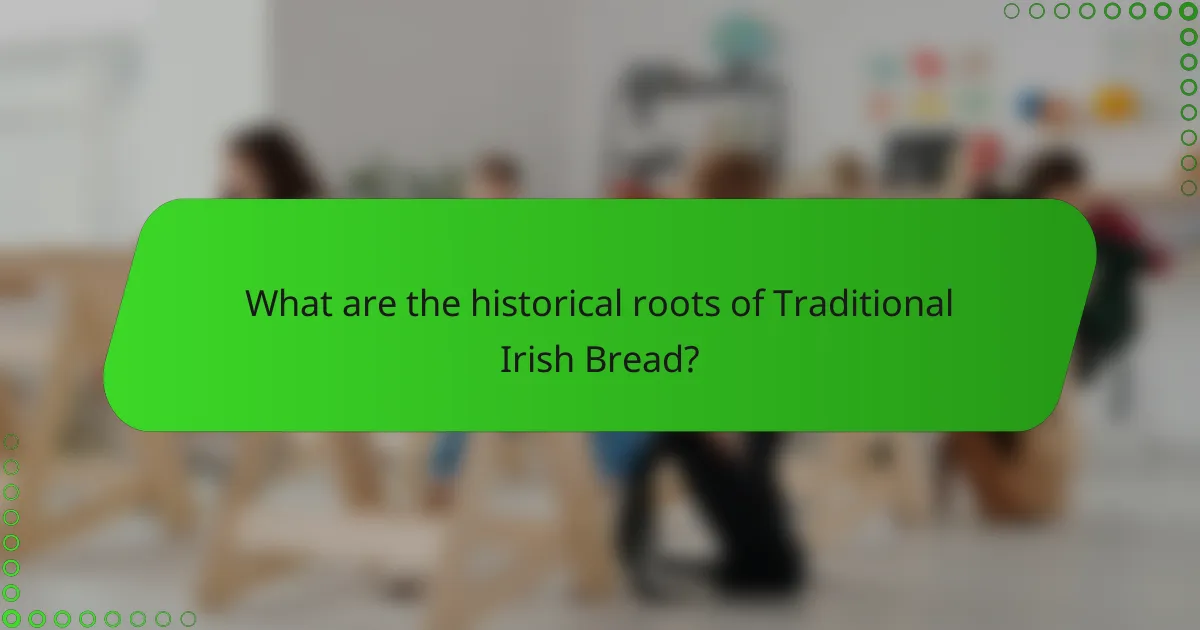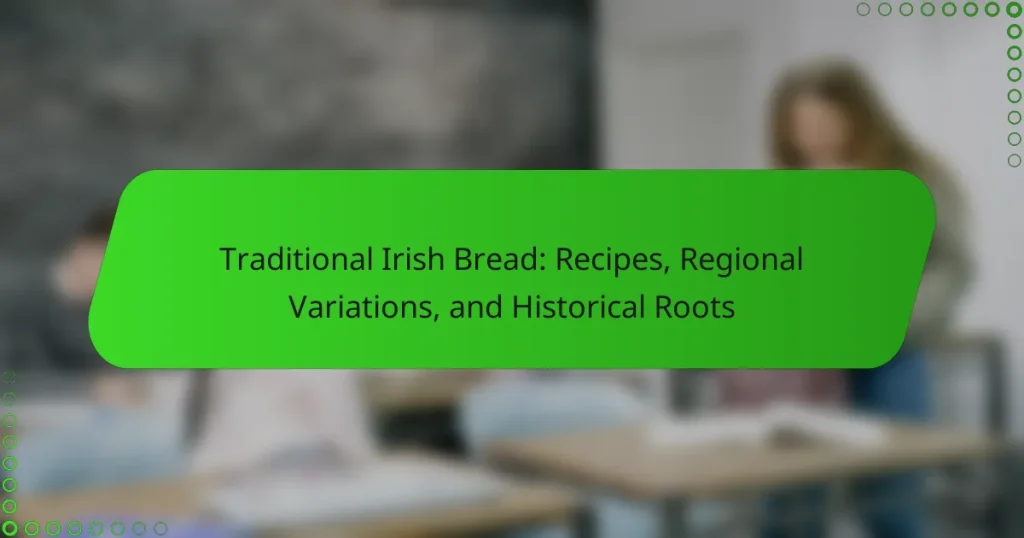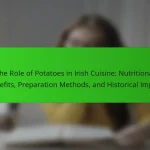Traditional Irish bread is a fundamental food in Ireland, characterized by simple ingredients such as flour, water, salt, and baking soda. The most notable variety is soda bread, which emerged in the 19th century and is known for its dense texture and slightly tangy taste. Other types include brown bread, made with wholemeal flour for a nutty flavor, and potato bread, or Boxty, which incorporates mashed potatoes. Each type features regional variations influenced by local grains and agricultural practices. The historical significance of traditional Irish bread reflects Ireland’s cultural heritage and the evolution of its food practices, particularly during events like the Great Famine.

What is Traditional Irish Bread?
Traditional Irish bread is a staple food in Ireland, known for its simple ingredients and rustic texture. It typically includes flour, water, salt, and baking soda as a leavening agent. The most famous type is soda bread, which dates back to the 19th century. This bread is characterized by its dense crumb and slightly tangy flavor. Traditional recipes often vary by region, incorporating local grains and buttermilk. Irish bread has historical significance, as it was a primary source of sustenance for many families. Its preparation methods reflect Ireland’s agricultural practices and cultural heritage.
How is Traditional Irish Bread defined?
Traditional Irish bread is a type of bread that typically uses simple ingredients like flour, baking soda, buttermilk, and salt. It often features a dense, hearty texture and a slightly tangy flavor due to the fermentation of buttermilk. Common varieties include soda bread and brown bread, which are staples in Irish cuisine. Soda bread relies on baking soda as a leavening agent, while brown bread is made with wholemeal flour. Historically, this bread was made to accommodate the local agricultural practices and available ingredients in Ireland. The use of buttermilk dates back centuries, as it was a common byproduct of butter-making. Traditional Irish bread is often served with meals or enjoyed with butter and jam.
What are the key ingredients of Traditional Irish Bread?
The key ingredients of Traditional Irish Bread are flour, baking soda, salt, and buttermilk. Flour is the primary base for the bread. Baking soda acts as the leavening agent. Salt enhances the flavor of the bread. Buttermilk provides moisture and a slight tang. These ingredients combine to create a dense, hearty loaf. Traditional recipes often use wholemeal flour for added texture. The simplicity of these ingredients reflects the bread’s historical roots in Irish cuisine.
What are the common forms of Traditional Irish Bread?
The common forms of Traditional Irish Bread include soda bread, brown bread, and potato bread. Soda bread is made using baking soda as a leavening agent. It is often prepared with buttermilk, giving it a distinct flavor. Brown bread typically consists of wholemeal flour, which adds nutritional value. Potato bread incorporates mashed potatoes into the dough, creating a moist texture. These breads have deep cultural roots in Ireland, often linked to local ingredients and traditional baking methods. Each type of bread reflects regional variations and historical practices in Irish cuisine.
Why is Traditional Irish Bread significant in Irish culture?
Traditional Irish Bread is significant in Irish culture due to its historical and social importance. It has been a staple food in Ireland for centuries. Traditionally, it was made using simple ingredients like flour, water, and baking soda. This simplicity reflects the resourcefulness of Irish communities.
Irish bread often symbolizes hospitality and community. It is commonly served at gatherings and celebrations. The act of baking bread brings families together, reinforcing cultural ties.
Different regions in Ireland have their own variations of bread, showcasing local ingredients and traditions. For example, soda bread is a well-known type that reflects the adaptation to available resources.
Overall, Traditional Irish Bread serves as a cultural emblem, representing Irish heritage, resilience, and the importance of community.
How has Traditional Irish Bread influenced Irish culinary traditions?
Traditional Irish Bread has significantly influenced Irish culinary traditions by serving as a staple food. Its preparation methods have shaped communal baking practices across Ireland. Traditional recipes often utilize simple ingredients like flour, water, and baking soda. This simplicity reflects the resourcefulness of Irish households throughout history. The bread is often paired with local dishes, enhancing flavors and nutritional value. Additionally, it plays a central role in cultural celebrations and rituals. For instance, soda bread is commonly served during festive occasions. Overall, Traditional Irish Bread embodies the essence of Irish heritage and communal identity.
What role does Traditional Irish Bread play in Irish celebrations and rituals?
Traditional Irish Bread is integral to Irish celebrations and rituals. It symbolizes hospitality and community during gatherings. For example, soda bread is often served at family events and festive occasions. This bread is traditionally baked for special feasts, such as St. Patrick’s Day. Additionally, it plays a role in funerals, where it is offered as a gesture of respect. The bread is also associated with the harvest season, reflecting gratitude for the land. In many households, the baking of traditional bread is a cherished family activity. Overall, Traditional Irish Bread embodies cultural heritage and communal ties in Irish life.

What are the different types of Traditional Irish Bread?
The different types of Traditional Irish Bread include Soda Bread, Brown Bread, and Potato Bread. Soda Bread is made with baking soda as a leavening agent. It is a staple in Irish households. Brown Bread typically contains wholemeal flour, giving it a nutty flavor. Potato Bread, also known as Boxty, incorporates mashed potatoes into the dough. Each type has unique regional variations across Ireland. For example, Soda Bread can vary in thickness and texture based on local recipes. Traditional Irish breads often reflect the agricultural practices and available ingredients of their regions.
What are the most popular varieties of Traditional Irish Bread?
The most popular varieties of Traditional Irish Bread include soda bread, brown bread, and potato bread. Soda bread is made using baking soda as a leavening agent, which gives it a distinctive texture. Brown bread is typically made with wholemeal flour, providing a hearty flavor and dense consistency. Potato bread, also known as boxty, incorporates mashed potatoes into the dough, resulting in a unique taste and texture. These breads have deep cultural significance in Ireland, often served with meals or enjoyed on their own. Traditional recipes have been passed down through generations, showcasing regional variations and local ingredients.
How does Soda Bread differ from Brown Bread?
Soda bread differs from brown bread primarily in its leavening agent. Soda bread uses baking soda as a leavening agent, while brown bread typically relies on yeast. The absence of yeast in soda bread results in a quicker preparation time. Soda bread has a denser texture compared to the lighter, airier structure of yeast-leavened brown bread. Additionally, soda bread often includes buttermilk, which reacts with the baking soda to create a unique flavor profile. Brown bread, on the other hand, is usually made with whole wheat flour, giving it a nutty taste. The two breads also differ in their traditional uses; soda bread is often served with meals, while brown bread is commonly enjoyed as a standalone snack.
What unique ingredients are found in Irish Potato Bread?
Irish Potato Bread uniquely includes mashed potatoes as a primary ingredient. The use of potatoes gives the bread its distinctive texture and flavor. Typically, this bread also contains flour, baking powder, salt, and sometimes butter or milk. The addition of mashed potatoes enhances moisture and density. Historically, this bread originated from the need to use leftover potatoes. Its roots trace back to the potato famine in Ireland, which popularized potato-based recipes. Irish Potato Bread is often enjoyed with butter or as a side dish. The unique combination of these ingredients differentiates it from other types of bread.
What regional variations exist in Traditional Irish Bread?
Traditional Irish bread includes several regional variations. In the north, soda bread is often made with buttermilk and may include currants or raisins. In the west, brown soda bread is common, using wholemeal flour for a denser texture. The south is known for its soft, sweet soda bread, sometimes enriched with sugar and spices. In Dublin, a unique variation called “Dublin Coddle Bread” is sometimes served with the traditional stew. Each region’s climate and available ingredients influence these variations. For instance, coastal areas often incorporate seaweed or local grains. These differences reflect Ireland’s diverse agricultural practices and cultural influences.
How does Traditional Irish Bread vary across different provinces in Ireland?
Traditional Irish bread varies significantly across different provinces in Ireland. In the north, soda bread is prevalent, often made with buttermilk. The texture is dense and hearty, suitable for the colder climate. In the west, particularly in Galway, brown bread is common, incorporating wholemeal flour and sometimes oats. This variety is known for its nutty flavor and health benefits. In the east, especially Dublin, white soda bread is popular, characterized by its lighter texture and slightly sweet taste. The south, particularly Cork, features a unique version called “cork brown bread,” which often includes treacle for added sweetness. Each province’s bread reflects local ingredients and cultural influences, showcasing Ireland’s diverse culinary heritage.
What are the unique characteristics of Northern Irish Bread?
Northern Irish bread is distinguished by its unique ingredients and preparation methods. It often incorporates locally sourced ingredients, such as buttermilk and soda, which give it a distinct flavor. The use of baking soda instead of yeast is a key characteristic, resulting in a quicker preparation process. Traditional varieties include soda farls and potato bread, both of which are integral to Northern Irish cuisine. Soda farls are typically cooked on a griddle, creating a crispy exterior. Potato bread is made with mashed potatoes, adding moisture and a unique texture. These breads are often served alongside breakfast or as part of a traditional Ulster fry. The regional variations highlight the cultural significance of bread in Northern Ireland’s culinary heritage.

What are the historical roots of Traditional Irish Bread?
Traditional Irish bread has its roots in ancient Celtic culture. The Celts used simple ingredients like barley and oats for bread-making. These grains were readily available in Ireland’s climate. Over time, bread became a staple food for the Irish population. In the 19th century, the introduction of soda bread marked a significant evolution. This method utilized baking soda as a leavening agent instead of yeast. The Great Famine in the mid-1800s further influenced bread consumption patterns. Traditional Irish bread reflects the agricultural practices and social history of Ireland.
How did Traditional Irish Bread evolve over time?
Traditional Irish bread evolved through various historical and cultural influences. Initially, it was made from simple ingredients like barley and oats. The introduction of wheat in the 19th century changed its composition. Traditional methods included baking on griddles or in open fires. Over time, the use of baking soda became common, leading to soda bread. Regional variations emerged, reflecting local ingredients and practices. For example, brown bread became popular in rural areas for its nutritional value. Today, traditional Irish bread continues to be a staple in Irish cuisine, showcasing its rich history and adaptability.
What historical events influenced the development of Traditional Irish Bread?
The development of Traditional Irish Bread was influenced by several historical events. The arrival of the Normans in the 12th century introduced new baking techniques and ingredients. The Great Famine in the mid-19th century led to a reliance on simpler, more affordable bread made from soda instead of yeast. The introduction of buttermilk as an ingredient was also a response to the agricultural practices of the time. The rise of the Irish diaspora in the 19th and 20th centuries spread traditional recipes globally. These events collectively shaped the ingredients and methods used in Traditional Irish Bread.
How have traditional baking methods changed through the years?
Traditional baking methods have evolved significantly over the years. Initially, baking was done using simple clay ovens or open fires. These methods required extensive skill and knowledge of temperature control. With the advent of industrialization in the 19th century, mechanized processes began to emerge. This included the introduction of gas and electric ovens, which provided more consistent heat.
Additionally, the availability of commercial yeast revolutionized bread-making. It replaced traditional sourdough starters, allowing for quicker fermentation and rising times. Modern baking now often incorporates specialized equipment like mixers and proofing cabinets.
Furthermore, the rise of global cuisine has influenced traditional recipes. Ingredients and techniques from other cultures have been integrated into Irish baking. This has led to a greater variety of breads and baking styles. Overall, these changes reflect advancements in technology and cultural exchange.
What cultural influences have shaped Traditional Irish Bread?
Traditional Irish Bread has been shaped by various cultural influences including Celtic, Viking, and British traditions. The Celts introduced the use of barley and oats, which are staple ingredients in many traditional breads. Viking settlers contributed to the baking techniques and the incorporation of rye flour. British influence brought about the use of wheat flour and the concept of leavened bread. Each of these cultures added unique flavors and methods to the bread-making process. The blending of these influences resulted in diverse regional variations, such as soda bread and brown bread. Traditional Irish Bread reflects the agricultural practices and available ingredients of Ireland’s history.
How did the introduction of new ingredients affect Traditional Irish Bread?
The introduction of new ingredients significantly altered Traditional Irish Bread. New ingredients like buttermilk, baking soda, and various grains enhanced flavor and texture. These ingredients replaced older methods that relied primarily on yeast and simple flour. The use of baking soda allowed for quicker preparation, changing the bread-making process. Buttermilk contributed to a richer taste and softer crumb. Additionally, the incorporation of whole grains increased nutritional value. Historical records indicate that these changes emerged during the 19th century, reflecting evolving dietary preferences. The adaptation of recipes continues to influence modern variations of Traditional Irish Bread today.
What impact did immigration have on the evolution of Traditional Irish Bread?
Immigration significantly influenced the evolution of Traditional Irish Bread. Immigrants brought diverse baking techniques and ingredients. They introduced new flours and leavening agents. This led to variations in texture and flavor. For instance, the use of baking powder became more common. Cultural exchanges enriched traditional recipes. These adaptations helped traditional bread evolve to meet varying tastes. Historical records show that Irish immigrants in America created new bread styles. This evolution reflects the blending of Irish and immigrant culinary traditions.
What are some tips for making Traditional Irish Bread at home?
Use simple ingredients like flour, baking soda, salt, and buttermilk for Traditional Irish Bread. Measure the flour accurately, as too much can affect the texture. Mix the dry ingredients thoroughly before adding buttermilk. Knead the dough gently for a short time to maintain a light texture. Shape the dough into a round loaf and score the top with a cross. Bake in a preheated oven at 425°F (220°C) for about 30 minutes. Check for doneness by tapping the bottom of the loaf; it should sound hollow. Allow the bread to cool on a wire rack before slicing.
What common mistakes should be avoided when baking Traditional Irish Bread?
Common mistakes to avoid when baking Traditional Irish Bread include using the wrong flour type. Traditional Irish Bread typically requires strong white flour for the best texture. Another mistake is over-kneading the dough, which can lead to a dense loaf. Under-kneading can also be problematic, as it may prevent proper gluten development. Not allowing the dough to rest can result in a tough texture. Additionally, using too much or too little baking soda can affect the bread’s rise. Lastly, neglecting to check the oven temperature can lead to uneven baking. These factors are crucial for achieving the desired flavor and texture in Traditional Irish Bread.
How can one achieve the best texture and flavor in Traditional Irish Bread?
To achieve the best texture and flavor in Traditional Irish Bread, use high-quality ingredients and proper techniques. Start with a strong bread flour that contains sufficient protein for structure. Incorporate buttermilk for moisture and a slight tang, which enhances flavor. Knead the dough gently to develop gluten without overworking it. Shape the dough into a round loaf to encourage even baking. Bake in a preheated oven at a high temperature to create a crusty exterior. Additionally, allowing the bread to cool completely before slicing improves texture. These practices are rooted in traditional methods, ensuring authenticity and quality.
Traditional Irish Bread is a staple food characterized by its simple ingredients, including flour, baking soda, salt, and buttermilk, resulting in a dense and hearty texture. The article explores various forms of this bread, such as soda bread, brown bread, and potato bread, highlighting their regional variations and historical significance in Irish culture. It also discusses the evolution of traditional baking methods, the cultural influences that shaped these breads, and provides tips for making authentic Irish bread at home. Overall, the article offers a comprehensive overview of the recipes, regional differences, and the historical roots of Traditional Irish Bread.


